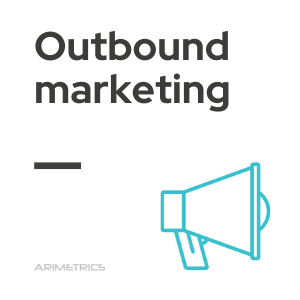 Definition:
Definition:
Outbound marketing is a traditional advertising strategy in which a company initiates communication and sends its message to an audience in a one-way manner, without expecting an immediate response. Common examples include television and radio commercials, print advertising in newspapers, magazines, brochures, catalogs, and sending unsolicited e-mails.
Outbound marketing vs. inbound marketing
Outbound marketing is opposed to inbound marketing where customers reach the company through strategies such as content marketing and search engine optimization. Although outbound marketing is more difficult to control and often less cost-effective, many organizations continue to spend up to 90% of their marketing budgets on these traditional tactics. To improve sales and marketing ROI, companies should consider allocating more of their budget to inbound marketing. However, implementing an inbound marketing strategy can be complex and time consuming. Outbound marketing seeks to reach consumers primarily through media advertising. Depending on the channel used, the approach can range from very broad (such as television advertising) to more personal (such as face-to-face meetings) or “personal impersonal” (such as cold calls or emails). Each outbound marketing method generates sales opportunities that are subsequently managed by the sales team.
Difficulties of outbound marketing
Outbound marketing presents the following challenges:
- Difficulties in tracking return on investment (ROI): It is difficult to accurately measure the impact of outbound marketing campaigns.
- Increased blocking techniques: Consumers are increasingly using tools to avoid intrusive advertising, such as spam filters and on-demand TV services.
- High cost, low return: Outbound marketing can be expensive and does not always offer a proportional return on investment.
Strategies to improve outbound marketing
Here are some effective strategies to improve outbound marketing strategies:
- Audience segmentation: Identify and target specific market segments to improve the relevance and effectiveness of advertising messages.
- Integration with digital marketing: Combine outbound marketing tactics with digital strategies to create more cohesive and measurable campaigns.
- Message personalization: Adapt advertising messages to the needs and preferences of consumers to increase engagement and conversion.
Examples of outbound marketing
Examples of outbound marketing include the following:
- Television and radio commercials: These mass media allow companies to reach a wide audience with advertising messages designed to capture the attention of viewers and listeners.
- Print advertising: Includes advertisements in newspapers, magazines, brochures and catalogs. This form of advertising continues to be effective in reaching specific audiences, especially in sectors where print media have a strong presence.
- Cold calling: This technique involves contacting potential customers by telephone without prior notice, with the objective of informing them about products or services and generating interest.
- Unsolicited e-mails: Although less popular due to spam regulations, some companies still use mass e-mails to try to capture the attention of new customers.
- Outdoor advertising: Billboards, billboards and advertisements on public transportation are examples of how companies can use physical space to promote their products or services.
- Events and trade fairs: Participating in exhibitions and trade fairs allows companies to interact directly with potential customers and partners, presenting their products in a tangible way.
- Direct mail advertising: Sending catalogs, brochures and special offers by postal mail continues to be a strategy used to reach consumers in their homes.
